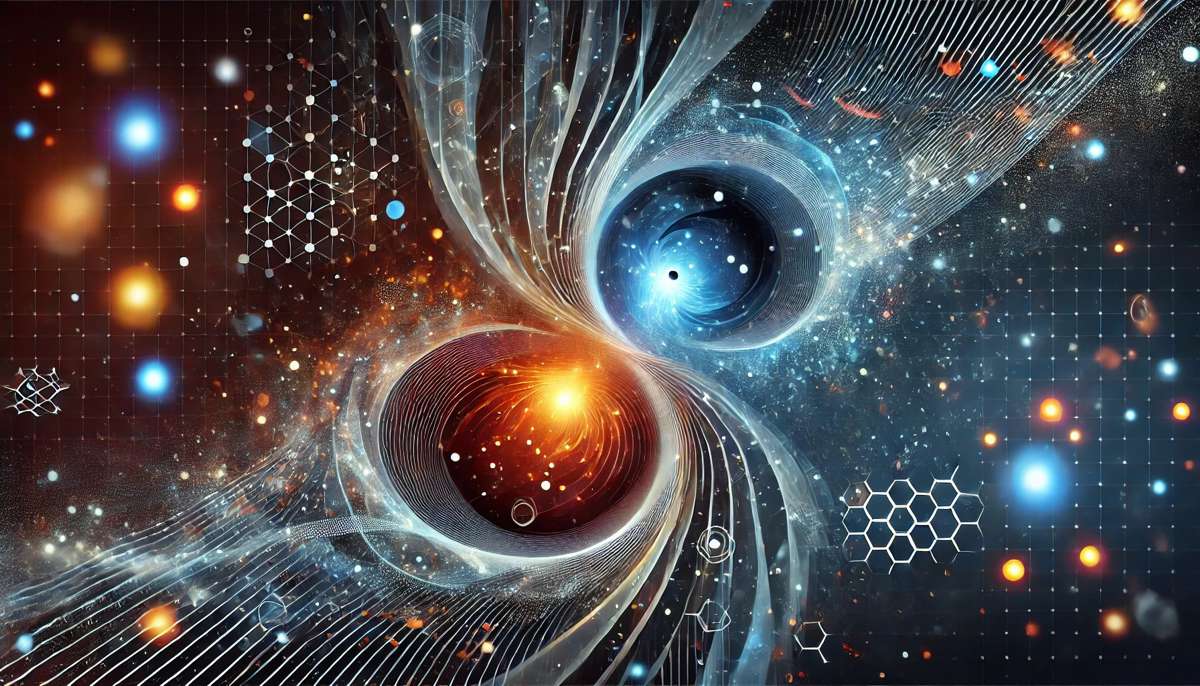New Theory Unites Quantum Physics and General Relativity
Scientists have unveiled a revolutionary breakthrough that may finally unite the seemingly incompatible worlds of quantum physics and general relativity.
This ground-breaking theory, recently published in a leading academic journal, promises to transform our understanding of the cosmos, reshaping how we think about black holes, the nature of space-time, and even the very fabric of reality itself.
The Ultimate Theory of Everything?
For decades, physicists have grappled with a fundamental problem: how to reconcile the unpredictable, bizarre behaviour of particles at the quantum level with the smooth, predictable flow of space and time described by Einstein’s theory of general relativity. The two pillars of modern physics, though both incredibly successful in their domains, have stubbornly refused to fit together in a single, unified framework. Until now.
A team of pioneering scientists, led by Adrian David Cheok of Nanjing University of Information Science and Technology and Chavis Srichan of Khon Kaen University, have proposed a new theory that could finally bridge this divide. Published in the prestigious journal Astroparticle Physics, their paper, titled “On the Same Origin of Quantum Physics and General Relativity from Riemannian Geometry and Planck Scale Formalism,” details a radical approach that redefines our understanding of space-time and energy. This theory suggests that the universe operates on a hidden geometric and energetic level, merging quantum mechanics and general relativity in a surprising harmony.
The Mystery of Space-Time Unveiled
At its core, the new theory challenges conventional notions of space and time. By leveraging Riemannian geometry and Planck-scale formalism, the researchers propose that both quantum mechanics and general relativity are not just different sides of the same coin, but originate from a deeper, unified structure. This hidden layer of reality could be the missing link that scientists have been searching for—a fundamental blueprint that dictates the behaviour of the universe from the smallest subatomic particles to the vast, curving expanse of galaxies.
Dr. Cheok and his team argue that by understanding this deeper geometric nature of the cosmos, we could resolve many of the long-standing contradictions between the quantum and relativistic worlds. “Our approach fundamentally reimagines how space-time is constructed,” the authors state in their paper. “It opens up new possibilities for understanding gravity, quantum fields, and the interactions that shape our universe.”
This theory not only proposes a solution to one of the most profound puzzles in physics but also sets the stage for a new era of scientific discovery. If proven correct, it could unravel the mysteries behind black holes, dark matter, and the very formation of the universe itself.
Implications That Could Redefine Reality
What makes this discovery so compelling is not just the mathematics behind it, but the extraordinary implications it carries. For starters, this new framework could change our understanding of black holes. Traditionally seen as the ultimate cosmic sinkholes where gravity reigns supreme, black holes might not collapse into singularities at all. Instead, they could act as gateways to other dimensions, offering a tantalising glimpse into the unknown.
Moreover, the theory provides a possible explanation for some of the more puzzling observations made by the James Webb Space Telescope, such as “ghost” galaxies that seem to defy existing models of cosmic evolution. By introducing a unified view of space-time, this breakthrough might just hold the key to understanding these elusive phenomena.
The potential doesn’t stop there. The implications for technology and human exploration are equally staggering. Imagine a universe where the fabric of space-time itself could be manipulated, making faster-than-light travel or even time manipulation conceivable. While this may sound like the stuff of science fiction, the new theory brings such ideas closer to the realm of possibility.
A New Era of Physics?
Of course, as with any revolutionary idea, the scientific community is both excited and cautious. The publication of this theory has already sparked heated debates among physicists and cosmologists, with experts eager to explore, test, and, inevitably, challenge these new concepts. As researchers race to validate or refute the findings, the world watches with bated breath.
Dr. Cheok and his colleagues are fully aware of the impact their work could have on the field. “This is just the beginning,” says Cheok. “We expect that our theory will be scrutinised, tested, and refined, and we welcome that. The process of scientific discovery thrives on challenge and debate, and we believe our work opens new pathways that are worth exploring.”
The peer-reviewed acceptance of this theory by Astroparticle Physics is a significant validation, but the road ahead is still long. Experimental verification, particularly at the extreme scales where quantum mechanics and relativity collide, remains a formidable challenge. Nevertheless, this theory has already achieved what many thought impossible: a coherent, mathematically sound framework that unites two of the most successful theories in physics.
What’s Next?
So, where does this leave us? For starters, the publication of this theory marks a turning point in theoretical physics, pushing the boundaries of what we know—and what we thought we knew—about the universe. It invites a new wave of research that could lead to breakthroughs not only in cosmology but also in technology, potentially impacting everything from particle physics to space exploration.
This is a moment of profound opportunity. If validated, the theory could revolutionise how we approach some of the biggest questions in science. It could help us understand the true nature of space, time, and energy, and unlock secrets that have eluded humanity for centuries.
As physicists and researchers dive deeper into this new framework, one thing is clear: the unification of quantum physics and general relativity is not just a scientific triumph; it’s a step towards a more comprehensive understanding of our universe. For those on the cutting edge of theoretical physics, this breakthrough is a beacon of hope—a sign that even the most stubborn mysteries of the cosmos might one day be solved.
Is the Future is Here?
This unifying theory stands as a testament to human curiosity and the relentless pursuit of knowledge. While challenges remain, the potential rewards are immense. As scientists continue to explore, debate, and build upon these revolutionary ideas, the path forward promises to be as exciting as the discovery itself.
The ultimate theory of everything may not just change our understanding of the universe; it may change our place within it.




















